Estimates of life expectancy at Scotland level and Council area presented in this chapter are based on the revised population estimates which take into account 2011 Census results. However, the estimates of life expectancy by urban/rural and deprivation still use population estimates based on the 2001 Census as they require the revised life expectancy estimates at these geographies, which are not yet available.
Although mortality rates in Scotland have generally fallen more slowly than in the rest of the UK and elsewhere in Europe, the improvements are still considerable and the impact is reflected in the steadily rising expectation of life.
The expectation of life at birth is a commonly used measure of mortality which is particularly helpful in comparing the 'health' of a nation through time and for making comparisons with other countries as well as for areas within Scotland. Figure 4.1 shows that the expectation of life at birth in Scotland has improved greatly over the last 30 years, increasing from 69.1 years for males and 75.3 years for females born around 1981 to 76.8 years and 80.9 years respectively for those born around 2012. Figure 4.1 also illustrates that improvements in life expectancy at birth are projected to continue, rising to 82.0 years for males and 85.5 years for females by 2037.
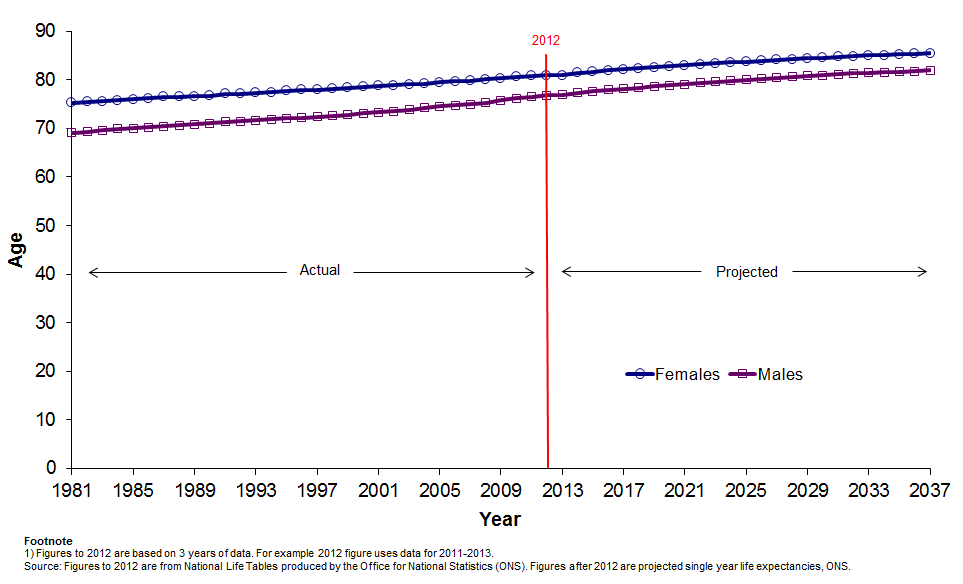
In addition, Figure 4.1 shows that the gap between male and female life expectancy at birth has decreased from 6.2 years in 1980-1982 to 4.1 years in 2011-2013 and has been closing since 2000-2002.
The improvement in life expectancy at birth for males and females in Scotland since 1980- 1982 can also be seen in Figure 4.2a (males) and Figure 4.2b (females). Comparisons are given with life expectancy in the United Kingdom (UK), countries within the UK and the countries that typically have the highest and lowest life expectancy in the European Union (EU) (Sweden and Lithuania for males and Spain and Romania for females).
Figures 4.2a and 4.2b show that Scottish males and females have relatively low expectation of life at birth compared with the rest of the UK. The UK average is 78.7 years for males and 82.6 years for females. The gap between UK and life expectancy in Scotland is now wider than in 1980-1982 by 0.5 years for males and 0.3 years for females.
Scottish male life expectancy has improved since 1980-1982, reducing the gap (currently 2.6 years) with Sweden, the country with the highest life expectancy, and increasing the gap with Lithuania, the country with the lowest life expectancy in the EU. Lithuania's male life expectancy has been varied since 1980-1982 with the lowest figure recorded in 1993- 1995 of 62.5 years.
For females however, the gap (currently 4.1 years) between Scotland and Spain, the country with one of the highest female life expectancy in the EU, has become wider since 1980-1982. For the same period, the gap between Scotland and Romania, the country with one of the lowest female life expectancy, has widened too although Romania has closed the gap compared with the life expectancy observed in the mid-1990s.
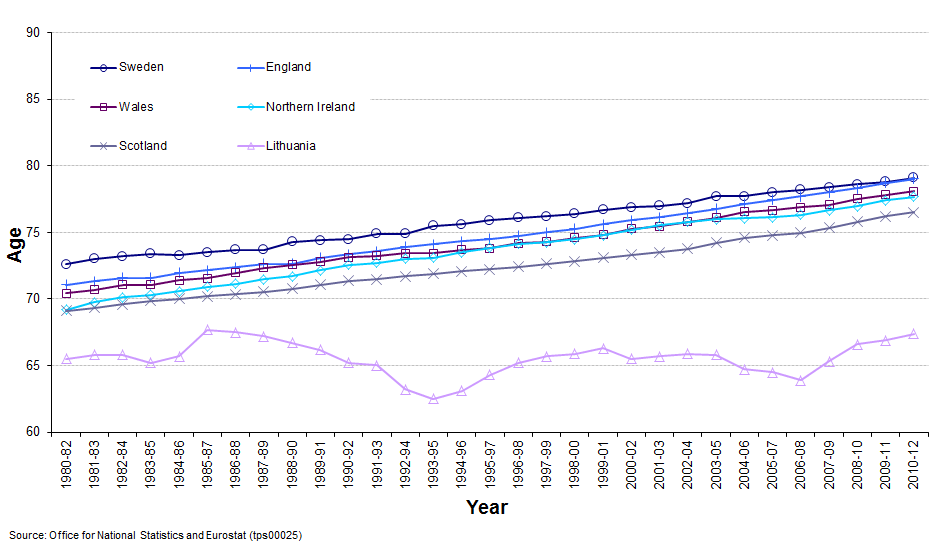
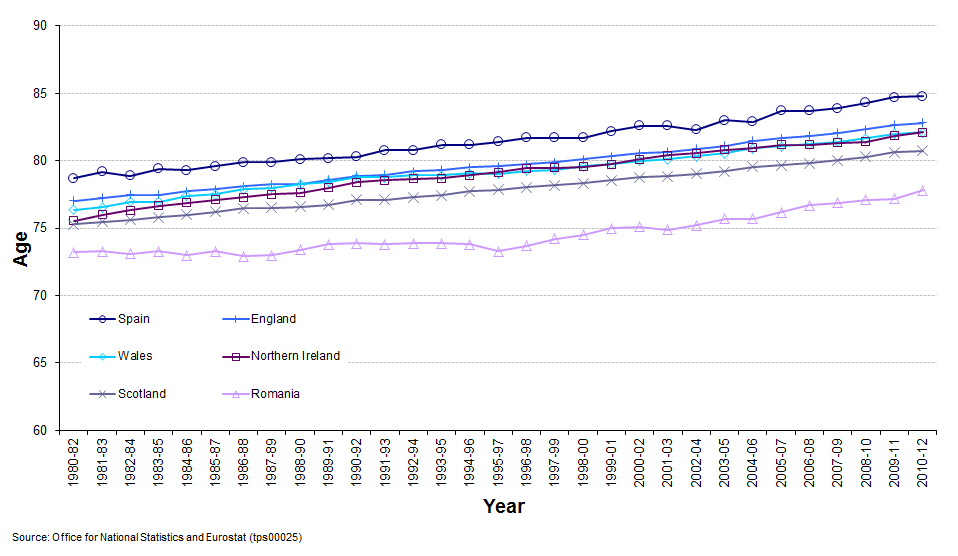
Within Scotland, there are considerable differences in life expectancy at birth between different Council areas as illustrated in Figure 4.3. For males, the Council area with the lowest life expectancy was Glasgow City (72.6 years), and the Council area with the highest life expectancy was East Dunbartonshire (80.1 years), 7.5 years more than Glasgow City. For females, East Dunbartonshire also had the highest life expectancy (83.4 years), 4.9 years more than Glasgow City, the area with the lowest figure (78.5 years).
There are also differences between urban and rural areas as shown in Figure 4.4. Males in rural areas - remote and accessible - can expect to live just over 3.5 years longer (78.0 and 78.3 years respectively) than males in large urban areas (74.5 years). Females in rural areas - remote and accessible - can expect to live around 2 years longer (82.2 and 81.8 years respectively) than females in large urban areas (79.8 years).
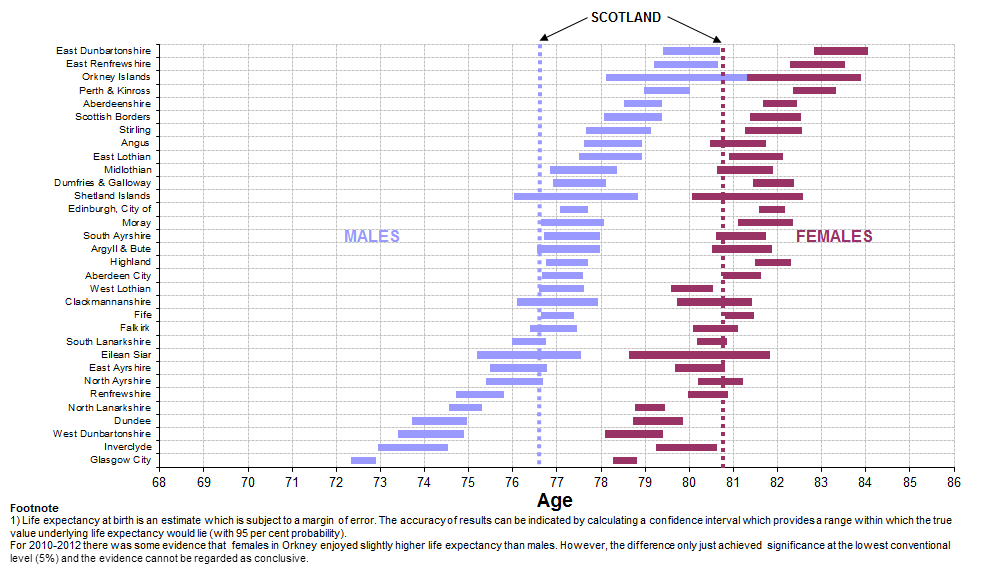
Please note: the Scotland-level life expectancy estimates shown in this chart are for use only as a comparator for the corresponding sub-Scotland-level figures. The definitive Scotland-level life expectancy estimate (based on national life tables) is published by the Office for National Statistics.
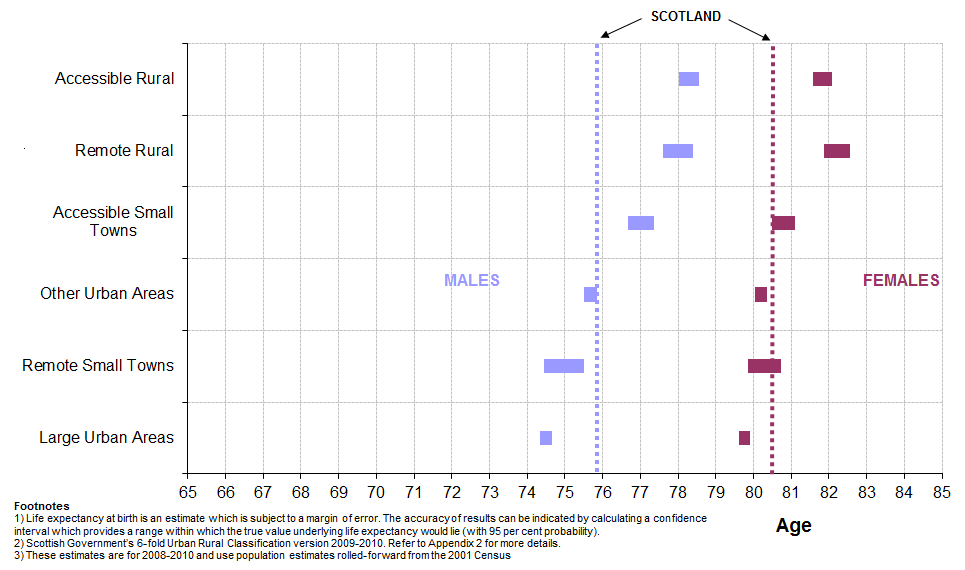
Please note: the Scotland-level life expectancy estimates shown in this chart are for use only as a comparator for the corresponding sub-Scotland-level figures. The definitive Scotland-level life expectancy estimate (based on national life tables) is published by the Office for National Statistics.
Life expectancy decreases as deprivation increases, as illustrated by Figure 4.5. Males in the 10 per cent least deprived areas of Scotland can expect to live around 13.1 years longer than those in the 10 per cent most deprived areas (81.4 years compared with 68.2 years). Females in the 10 per cent least deprived areas of Scotland can expect to live around 9.0 years longer than those in the 10 per cent most deprived areas (84.6 years compared with 75.7 years).
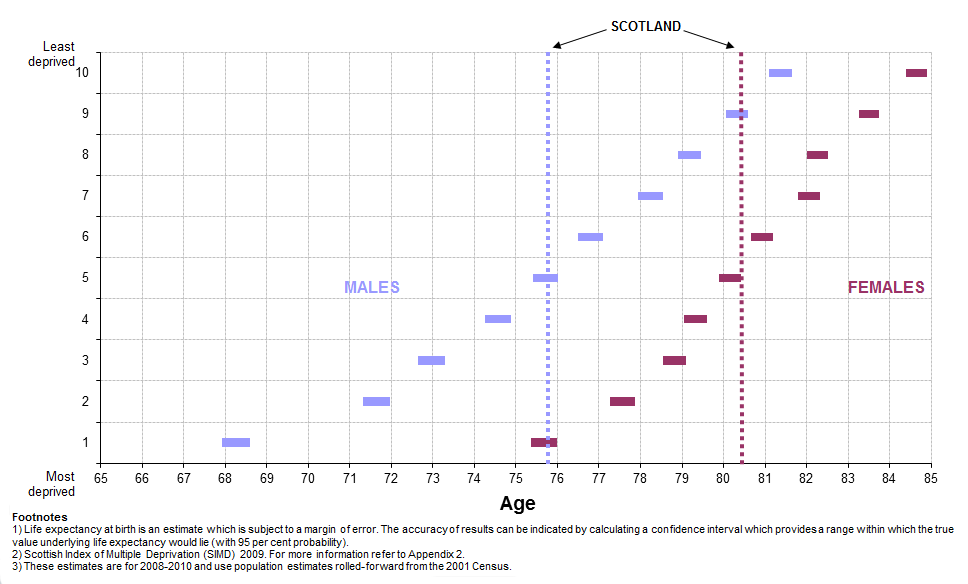
Please note: the Scotland-level life expectancy estimates shown in this chart are for use only as a comparator for the corresponding sub-Scotland-level figures. The definitive Scotland-level life expectancy estimate (based on national life tables) is published by the Office for National Statistics.
A useful extension of life expectancy estimates is information on Healthy Life Expectancy (HLE) which is published by the Information and Statistics Division of the NHS. HLE is defined as the number of years people can expect to live in good health. The difference between HLE and life expectancy indicates the length of time people can expect to spend in poor health. More information on HLE in Scotland is available on the website of the Scottish Public Health Observatory (ScotPHO): www.scotpho.org.uk
More detailed information about Scotland's life expectancy can be found within the Life Expectancy section of the NRS website.